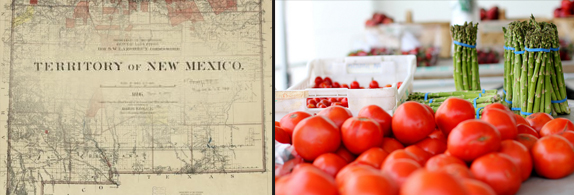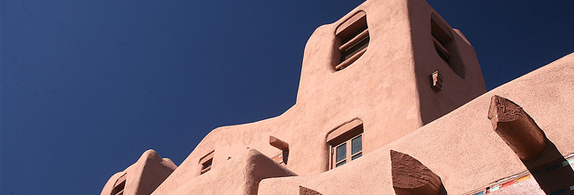Food Security and the Urban/Rural Conflict in New Mexico

When a big blizzard hit New Mexico just after Christmas in 2006, it closed down the interstates for so many days that grocery stores were running out of food. Without an unbroken stream of 18-wheelers moving on 1-25 and I-40, we have about a week’s worth of food on market shelves. In 2006 it was estimated that only 3% of the food we eat is produced locally (The Orphaned Land, pg. 80), including a mere 2% of our beef products.
New Mexico’s food security is always perilously close to the edge. After 2006, however, the market for local food increased steadily and dramatically, though it hasn’t come close to creating a truly sustainable local food economy, one that can sustain us when food imported from other states gets hard to come by because of regional drought, weather disasters, or increasing fuel costs. Even giant food transporters like Sysco have denationalized their focus, creating local food distribution networks and state centered transport systems. Sysco New Mexico LLC has a service area that includes all of our state, southern Colorado, eastern Arizona and El Paso. It focuses on transporting local produce to market as well as delivering national and international brands. Sysco changed from operating an exclusively national and international network some 15 years ago when rising fuel prices caused a refocusing on local food.
At the turn of the 20th Century the Middle Rio Grande was known as the American Nile. Farmers grew enough fruit and vegetables to ship trainloads to Arizona and California markets for many years. Farmers outside of Grants near Bluewater Lake grew carrots and broccoli in such abundance that they kept their markets in California despite the booming agribusiness in the California Central Valley. Surely, we can grow enough local produce to feed ourselves and make good lives.
A flourishing local agriculture is the key to New Mexico’s resiliency and sustainability in the “new normal” era of drought and long term increases in aridity during the climate change decades ahead. But local growers face major hurdles and they’re not only economic. The tension between rural ranchers and farmers and urban dwellers and their politicians and leaders is profound in New Mexico. You don’t have to look far to find it. This year’s legislative session, like all years, was full of the slow burning animosity between those who live on or close to the land and those who are almost detached from it in big cities living a globalized existence.
When it comes to water, the urban and rural stereotypes and animosities are impossible to miss. The rural, agricultural world view tends to see cities as smothering and corrupted, even wanton, places. The conservation values of rural life view cities as the source of America’s wasteful throwaway culture and the magnet for globalized corporate business practices that are an anathema to small local agricultural business owners. They see urban water use as largely decorative, wasteful, and heedless of consequences.
Urban leaders and water rate payers are often heard to blame rural agricultural businesses for being profligate with water, using outdated irrigation systems, and growing crops that seem marginally beneficial to the public good. They think city water shortages can be relieved by a more efficient use of water by farmers and by purchasing rural water rights and turning them into what they consider more productive urban uses.
The tensions between rural and urban New Mexico must be transcended somehow if local food production is to grow sufficiently to provide a food security safety net for rural and urban people alike. If Sysco is right and local and regional food production can eventually compete successfully with food that is genetically engineered to withstand days, sometimes weeks, of storage and travel, city residents will become prime markets for local food growers.
But for local agriculture to flourish in a drought, and ramp up its production, urban lending agencies will have to see farming as a long-term good investment. And New Mexico state government will need to pass laws that incentivize local agricultural production, underwrite health insurance and other employee benefits, and provide small business loans, technological advice, and the means of providing the subsidies necessary to make the transition from largely feed crop farming to edible and organic farming for urban consumers.
And then there’s the water issue and the land issue. In places like Bernalillo County and adjoining jurisdictions, the major water user is not agriculture, but urban residents and businesses. For more water to be freed up for more agriculture, and for the Rio Grande to begin reclaiming its title as the American Nile, cities will have to use less and less water. New Mexico cities will have to do what California and Arizona cities are doing—get serious about water banking, aquifer recharging, reusing gray water, treating and using black water and simple conservation. If San Francisco can reduce its per capita water consumption to 46 gallons a day, as opposed to ours at around 135 gallons, so can Albuquerque, Rio Rancho, and its bedroom communities. If Los Angles County can actually be a front runner in flood water recycling and conservation, so can Bernalillo County.
But how do we free up more land for agriculture? By reclaiming it from zombie developments and other wasteful remnants of the sprawl mentality of the l950s and l960s, and by subsidizing infill development and promoting a greater density of businesses and residential areas in our major cities.
Vegetable farmers and ranchers need an additional, low-water use cash crop to augment their production of edible goods. Hemp is the perfect product, but the governor vetoed a study of hemp production in New Mexico this month, despite a growing world-wide market for the multiple products of this highly versatile crop.
Some might think that moving toward a sustainable local food economy—one that can sustain itself as a viable business sector and sustain us as consumers of the basic staples of life—is a pie-in-the-sky hippie pipe dream. But farmers, ranchers, think tanks, locally owned regional corporations and universities all over the country are taking local food production very seriously. At the University of New Mexico this semester a class in the School of Community and Regional Planning called “Water, Community, and Food Systems in New Mexico” drew a large number of progressive thinking students interested in envisioning a pragmatic way of reviving the agricultural economy, and its cultural values, in our state. At one session I attended, a cattle rancher and a goat rancher, a representative of the New Mexico Cattle Growers Association and the director of the Quivira Coalition’s New Agrarian Program spoke to students on the realities of issues facing their businesses and communities. The New Agrarian Program, for instance, places student interns in immersion learning situations on New Mexico and southern Colorado farms and ranches to help them experience a way of life, and a profession, that needs their young energy to evolve.
Cities in New Mexico exist in a rural context, both culturally and economically. The old struggles and tensions between city folk and people who live off the land are wasteful and dangerous. Cities could well become the economic marketplace and financial context for local food growers and their products. This interlocking of rural and urban contexts might go a long way in defusing a political and cultural conflict that no longer represents a productive image of reality in our state.
Why We Love New Mexico: “Place Made”

The old argument of nature versus nurture has always seemed specious to me. Of course we are to some extent the product of our genes. Of course we are also the product of our environments and cultures. And yes, so much of what happens to us in either realm is a product of accident or choice and all their positive and negative possibilities. It’s never been about one or the other, but both.
When it comes to the nurture side of the ledger, though, I’ve always thought that the places and environments of our lives play an enormous role in the development of our personalities. But they get less credit than the influence of schools and parental upbringing.
As a self-identified New Mexican of over 57 years (I arrived here when I was l8), the influence of our landscape, our creative and cultural histories, our research institutions and our colleges and universities has been incalculable to my sense of identity and well-being. I feel myself to be as much “place made” as I am “gene made,” if not more. That’s surely the main reason I love New Mexico as much as I do. It has been the formative place of my life. And, of course, I am but one of uncountable many over the decades and centuries.
This sense of being made by a place, of having it inside your bones, of having it shape you and weather you, seems to be felt by people who have come here from other places with almost as much intensity as it is by people who were born here.
As one example among thousands, the first time I experienced Midnight Mass on Christmas Eve at San Felipe Pueblo in l962 when native dancers, chanters and drummers exploded into the church as Fra Angelico Chavez finished giving communion, that moment fixed in my mind and soul a communion across cultures and across eons that has never left me. It was similar to my first times in Chaco Canyon, or in Truchas or Trampas, or driving through the land around Galisteo and discovering petroglyphs on virtually every stone, the first time I saw Taos Pueblo, or the church at El Valle, or the first time I heard the great teacher and writer Sabine Ulibarri recite poems in his deep sonorous voice that sounded like the depth of Rio Grande Gorge.
If we’re lucky, as New Mexicans tend to be, we are the places we love and the places we inhabit. They work their magic on us. And in a very real way, they become the ground, the ecology, of who we are.
(Photos: Map by maps.bpl.org / CC; veggies by North Charleston Farmers Market / CC; Adobe building by Laszlo Ilyes / CC)

April 20, 2015